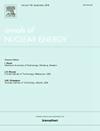Global sensitivity analysis using Gaussian process surrogate models & impact of thermophysical properties uncertainties on the steady-state operation of molten salt reactors
IF 1.9
3区 工程技术
Q1 NUCLEAR SCIENCE & TECHNOLOGY
引用次数: 0
Abstract
Measurement uncertainties in the thermophysical properties of molten salts affect the predicted steady-state operation of molten salt reactors (MSRs). We aim to quantify that impact using three MOOSE-based multiphysics models of MSRs: the molten-salt fast reactor (MSFR), the molten-salt reactor experiment (MSRE), and the molten-chloride reactor experiment (MCRE). For each model we perturb the fuel salt’s thermophysical properties using Gaussian and uniform distributions, then we analyze the impact on the statistical distributions of various quantities of interest (QoIs) that are representative of the steady-state operation of MSRs. These QoIs can be grouped into two categories: those related to energy and those related to flow. Our results demonstrate that while the resulting uncertainties depend on the considered QoI, they are predominantly influenced by density uncertainty. Specifically, for the MSFR, heat capacity and density have the greatest impact on uncertainty. In the MSRE, the key contributors are heat capacity and dynamic viscosity, while in the MCRE, thermal conductivity, dynamic viscosity and density are the most significant sources of uncertainty. In general, for energy-related QoIs in the MSFR and MSRE cases, the observed QoI distributions were Gaussian regardless of the distribution chosen for the input thermophysical properties, i.e., uniform or Gaussian. For the flow-related QoIs, the distribution of the QoI is dependent on the prior distribution. However, interestingly, multimodal distributions are observed for the energy-related QoIs of MCRE, suggesting a possible bifurcation behavior in the multiphysics model. Refining the mesh for the MCRE model causes the multimodal distributions to disappear suggesting that the bifurcation is spurious, nonphysical. This article establishes a more general framework for uncertainty quantification in MSRs that accounts for the nonlinearity of the underlying models.
求助全文
约1分钟内获得全文
求助全文
来源期刊

Annals of Nuclear Energy
工程技术-核科学技术
CiteScore
4.30
自引率
21.10%
发文量
632
审稿时长
7.3 months
期刊介绍:
Annals of Nuclear Energy provides an international medium for the communication of original research, ideas and developments in all areas of the field of nuclear energy science and technology. Its scope embraces nuclear fuel reserves, fuel cycles and cost, materials, processing, system and component technology (fission only), design and optimization, direct conversion of nuclear energy sources, environmental control, reactor physics, heat transfer and fluid dynamics, structural analysis, fuel management, future developments, nuclear fuel and safety, nuclear aerosol, neutron physics, computer technology (both software and hardware), risk assessment, radioactive waste disposal and reactor thermal hydraulics. Papers submitted to Annals need to demonstrate a clear link to nuclear power generation/nuclear engineering. Papers which deal with pure nuclear physics, pure health physics, imaging, or attenuation and shielding properties of concretes and various geological materials are not within the scope of the journal. Also, papers that deal with policy or economics are not within the scope of the journal.
 求助内容:
求助内容: 应助结果提醒方式:
应助结果提醒方式:


